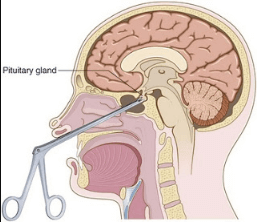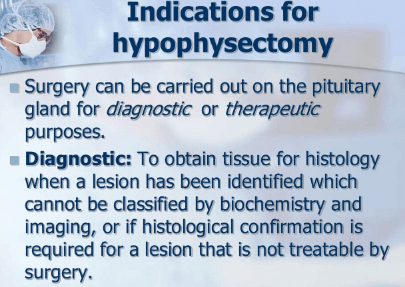Transsphenoidal Hypophysectomy
What Is Transsphenoidal Hypophysectomy?
Transsphenoidal hypophysectomy is a surgical method to remove a tumor of the pituitary gland. Pituitary gland is situated at the base of your brain behind the eyes. The gland produces hormones that control crucial body functions.

Purpose
The surgery is usually taken as a drastic step to remove tumors that have resisted other forms of treatment. A patient with Cushing’s syndrome may also need this surgery.
Cushing’s syndrome is associated with pituitary adenomas, a type of benign tumor that affects the pituitary gland. The syndrome may be caused by prolonged exposure to high levels of cortisol hormone to tissues. The aim of having this surgery is removing the tumor while preserving the gland.
Causes
Many of pituitary tumors are considered to be pituitary adenomas, which are slow glowing tumors caused by the cells in the pituitary gland.
There are different types of cells in pituitary gland that produce variety of hormones that affect how the body functions. Function adenomas are as a result of the cells producing an excess of one or more hormones in your body. The following are examples of Function adenomas:
1. Prolactinoma
This is a type of pituitary tumors that produces too much of prolactin hormone. Prolactin hormone is a reproduction hormone. The symptoms of prolactinoma depend on gender and age among other things. Prolactinoma is not common in children, but when it happens, it leads to headache and increase in weight.
In premenopausal women, prolactinoma can lead to low sex drive, irregular menstrual periods or total failure of menses. When prolactinoma becomes larger usually 10mm it can cause headache, loss in vision and hypopituitarism (hormone insufficiency).
2. Acromegaly
Acromegaly in adults and Gigantism in children are as a result of excess secretion of growth hormones. Growth hormones play crucial roles in ensuring that the body of a child grows and develops properly and keep healthy bones and muscles in adults.
Too much of growth hormones may disfigure your body and even lead to death if disfigurement is so acute. Patients with acromegaly can manifest the following symptoms:
- Unusual growth of the hands and feet
- Deep voice in men
- Facial changes such a s growth of the lips and nose
- Skin changes such as increased number of skin tags and excessive sweating.
3. Cushing’s disease
It is an acute condition where pituitary tumors produce adrenocorticotropic hormone (ACTH) that stimulates your adrenal glands to secrete too much cortisol hormone in the blood.
Increased cortisol hormone normalizes the body pressure, helps you cope with stressful situations. But when its level drops, it may cause low blood pressure and lead to severe stress that cause death.
Why Transsphenoidal Hypophysectomy?
Pituitary tumors can affect your vision leading to double, blurred and tunnel vision. It can disrupt the normal functioning of your body by interfering with body hormones. It can also disfigure your body. Transsphenoidal hypophysectomy is done to balance your body hormones to normalize your body functions, enhance your body shape and to improve vision.
What Happens Before Surgery?
You will make an official visit to the endocrinologist and neurosurgeon before surgery for consultation. If you have problems with vision, you will visit an ophthalmologist. During the visit, the surgeon explains to you the procedure, benefits and risks associated with the procedure. Then, you will sign consent forms and fill documents to inform the surgeon your medical history- surgery history, medicines used, allergic reaction and so forth.
If you are using non-steroidal anti-inflammatory medicines like Motrin and blood thinners such as aspirin, stop taking them one week before surgery. In addition, avoid smoking one week before because it may cause bleeding.
Surgery
The neurosurgeon makes an incision through one of your nose and removes the tumor via one of the nasal sinus. The surgery requires due diligence to avoid damaging the tissue near the pituitary gland. This implies that the success of this procedure depends on the skill and experience of the surgeon conducting the operation.

Types
Pituitary gland tumor can be removed through traditional microscopic or endoscopic technique. Microscopic method involves a surgeon making skin incision under your lips and removing portions of the nasal septum in order to clearly see the area and remove the tumor.
In endoscopic surgery, the surgeon makes incision through the nostril with the help of the endoscope and exposes the tumor and removes it.
Endoscopic surgery is preferred over microscopic method because of the following:
- There is very minimal disruption of the nostril tissue and hence no damage
- Endoscope enhances visualization of the pituitary gland and hence a surgeon can easily conduct the operation
- It is suitable to remove large tumors
- There is very little blood loss
- It preserves the pituitary gland
- Patients are able to safely go home after having the surgery
- There is very minimal complications.
Discharge Directives
After surgery, the surgeon will give instructions to you to help enhance the healing process. Such instructions include:
- The doctor prescribes narcotic drugs for you to relieve pain for a limited period of 2 to 4 weeks
- Drink a lot of water and eat food rich in fiber
- The doctor can also prescribe medicine to help control your hormone levels
- Avoid activities that can damage the surgical area such as drinking with a straw, blowing your nose, and bending.
Recovery and Prevention
To help you recover faster and heal from surgery, you have to visit your surgeon for regular checkups. During the visit, the surgeon will remove nasal splints and examine your surgical site for any problems. The surgeon will also determine whether to replace hormone medicines or not.
Risks Factors
- Every surgery has general risks such as blood clots, bleeding, allergic reactions to anesthesia and infection. Transsphenoidal hypophysectomy can cause the following complications to you:
- Loss of vision: Surgery can destroy your optic nerve causing loss of vision.
- Damages pituitary gland: During surgery, your pituitary gland can be injured. Research shows that damage to pituitary gland can occur when the tumor is large.
- Causes diabetic insipidus: Surgery can damage the posterior lobe of your pituitary gland, which makes you to urinate frequently and feel thirsty. It lasts between 1 to 3 days and can be corrected by medication such as desmopressin acetate.
- Cerebrospinal fluid (CSF) leak: During surgery, the fluid surrounding your brain can leak through the hole in skull.
- Causes meningitis: Cerebrospinal fluid (CSF) leak can make you develop meningitis.
- Congestion of the sinus: Surgery can lead to scars forming, something that obstructs the flow of air through your nose.
- Cause stroke: Surgery can damage carotid arteries and cavernous sinuses situated on either side of the pituitary gland obstructing the supply of blood to the brain, something that could result in stroke.
- Before you consider having transsphenoidal hypophysectomy, you need to know the risks involved or the complications likely to occur. You also need to know if you are a good candidate for this surgery. Some people may not be good candidates for transsphenoidal hypophysectomy.
Reference List
- Transsphenoidal Hypophysectomy. Available at https://radiopaedia.org/articles/transsphenoidal-hypophysectomy
- Hypophysectomy. https://www.uclh.nhs.uk/PandV/PIL/Patient%20information%20leaflets/Transsphenoidal%20hypophysectomy.pdf
- Transsphenoidal Hypophysectomy. http://www.royalberkshire.nhs.uk/patient-information-leaflets/transsphenoidal-hypophy.htm
- Hypophysectomy. http://www.surgeryencyclopedia.com/Fi-La/Hypophysectomy.html
- Pituitary Surgery. https://ccpd.ucsf.edu/treatment/pituitary-surgery
- Transsphenoidal Hypophysectomy. http://www.primehealthchannel.com/transsphenoidal-hypophysectomy-overview-procedure-and-complications.html
- Pituitary Adenomas. http://pituitary.ucla.edu/pituitary-adenomas
- Endoscopic Pituitary Surgery (transsphenoidal). http://www.mayfieldclinic.com/PE-EndoPitSurg.htm
